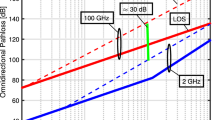Abstract
A method to compute the effects of a multipath propagation channel on a line-of-sight link consists in establishing a statistical model of the channel transfer function. It is then possible to compute the outage time previsions for various communication systems, or to compare these systems by means of their signatures. To carry out this method, it is first necessary to choose a representation model of the transfer function, then to establish on an experimental basis the joint statistics of the model parameters. The authors discuss the various steps in the construction and validation of such a model and compare several proposed models from the point of view of their applications. These points are illustrated by means of results from thepacem Iexperiment.
Analyse
Une méthode pour calculer les effets de la propagation par trajets multiples sur une liaison hertzienne consiste à établir un modèle statistique de la fonction de transfert du canal. Il est alors possible de calculer des prévisions de temps de coupure pour différents équipements ou de les comparer au moyen de leurs signatures. La mise en æuvre de cette méthode suppose le choix préalable d’un modèle de représentation de la fonction de transfert, puis l’établissement, à partir de mesures, de la statistique conjointe des paramètres du modèle. Les auteurs discutent des différentes phases de létablissement d’un modèle et de sa validation, et comparent dans l’optique d’une utilisation pratique, les divers modèles de représentation qui ont été proposés. Les divers points sont illustrés à partir des résultats obtenus sur les données de l’expériencepacem I.
Similar content being viewed by others
References
Sylvain (M.). Panorama des études sur les trajets multiples.Ann. Télécom., Fr. (1985),40, n∘ 11–12, pp. 547–564.
Lavergnat (J.),Sylvain (M.). Analyse théorique d’un canal de propagation en présence de trajets multiples.Ann. Télécom., Fr. (1985),40, n∘ 11–12, pp. 572–583.
Lavergnat (J.),Sylvain (M.). Statistiques de la fonction de transfert par trajets multiples en bande moyenne. Application à la prévision de la qualité.Ann. Télécom., Fr. (1985),40, n∘ 11–12, pp. 604–616.
Sylvain (M.)et al. Thepacem experiment on line-of-sight multipath propagation.Proc. URSI. Commission F Symposium, Louvain, Belgique (juin 1983), ESA-SP-194, pp. 13–23.
Rummler (W. D.). Time-and frequency-domain representation of multipath fading on line-of-sight microwave paths.Bell Syst. tech. J., USA (1980),59, n∘ 5, pp. 763–796.
Claverie (J.),Klapisz (C.). Meteorological features leading to multipath propagation observed in thePacem epériment.Ann. Telecom., Fr. (1985),40, n∘ 11–12, pp. 660–671.
Babler (G. M.). A study of frequency selective fading for a microwave line of sight narrowband radio channel.Bell Syst. tech. J., USA (1972),51, n∘ 3, pp. 731–757.
Liniger (M.). Sweep measurements of the transfer function of arf channel and their representation by polynomials.IEEE Internat. Conf. on Com., Philadelphie (1982), pp. 7.B.3. 1–7 B.3.5.
Liniger (M.). One year results of sweep measurements of a radio link.IEEE Internat. Conf. on Com., Boston (1983), pp. 6.2.3.1.–6.2.3.5.
Subramanian (M.),O’Brien (K. C.),Puglis (P. J.). Phase dispersion characteristics during fade in a micro-wave line-of-sight radio-channel.Bell Syst. tech. J., USA (1923),52, n∘ 10, pp. 1877–1902.
Greenstein (L. J.). A multipath fading model for terrestrial digital radio systems.IEEE Trans. COM, USA (1978),26, n∘ 8, pp. 1247–1250.
Greenstein (L. J.),Czekaj (B. A.). A polynomial model for multipath fading channel responses.Bell Syst. tech. J., USA (1980),59, n∘ 7, pp. 1197–1225.
Rummler (W. D.). A new selective fading model: application to propagation data.Bell Syst. tech. J., USA (1979),58, n∘ 5, pp. 1037–1071.
Jakes Jr (W. C.). An approximate method to estimate an upper bound of the effect of multipath delay distorsion on digital transmission.IEEE Trans. COM, USA (1979),27, n∘ 1, pp. 76–81.
Meyers (M. H.). Multipath fading characteristics of broad-band radio channels.IEEE Global Telecom. Conf., Atlanta (1984), pp. 4.5.1.1.–4.5.1.6.
Sakagami (S.),Hosoya (Y.). Some experimental results on in-band amplitude dispersion and a method for estimating in-band linear amplitude dispersion.IEEE Trans. COM, USA (1982),30, n∘ 8, pp. 1875–1887.
Levy (A.). Performances en taux d’erreur des modulations à grand nombre d’états en période d’évanouissement sélectif.Ann. Télécom., Fr. (1985),40, n∘ 9–10, pp. 617–625.
Martin (L.), Le Forestier (P.).Un analyseur de liaison. Note techniquecnet lab/mer/15 (1980).
Author information
Authors and Affiliations
Rights and permissions
About this article
Cite this article
Sylvain, M., Lavergnat, J. Modelling the transfer function in medium bandwidth radio channels during multipath propagation. Ann. Telecommun. 40, 584–603 (1985). https://doi.org/10.1007/BF02997455
Received:
Accepted:
Issue Date:
DOI: https://doi.org/10.1007/BF02997455
Key words
- Multipath propagation
- Radio wave
- Modelization
- Transfer function
- Transmission channel
- Statistical model
- Radio link
- Comparative study
- Mathematical model
- Physical model
- Parameter estimation




